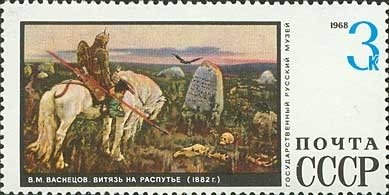Stamp: "A Knight at the Crossroad" 1882, V. M. Vasnetsov (1848-1926 (Soviet Union, USSR 1968)
"A Knight at the Crossroad" 1882, V. M. Vasnetsov (1848-1926 (Soviet Union, USSR 1968)
25 December (Soviet Union, USSR ) within release Paintings from Russian Museum in Leningrad goes into circulation Stamp "A Knight at the Crossroad" 1882, V. M. Vasnetsov (1848-1926 face value 3 Russian kopek
| Stamp "A Knight at the Crossroad" 1882, V. M. Vasnetsov (1848-1926 in catalogues | |
|---|---|
| Michel: | Mi:SU 3578 |
| Yvert et Tellier: | Yt:SU 3445 |
Stamp is horizontal format.
Also in the issue Paintings from Russian Museum in Leningrad:
- Stamp - "The Reapers" 1820, A.G. Venetsianov (1780-1847) face value 1;
- Stamp - "The Last Day of Pompeii" 1833, K. P. Bryullov (1799-1852) face value 2;
- Stamp - "A Knight at the Crossroad" 1882, V. M. Vasnetsov (1848-1926 face value 3;
- Stamp - «Conquering a Snow Town» 1891, V. I. Surikov (1848-1916) face value 4;
- Stamp - "Lake" 1900, I. I. Levitan (1860-1900) face value 6;
- Stamp - "1919. Alarm" 1934, K. S. Petrov-Vodkin (1878-1939) face value 10;
- Stamp - "The Defence of Sevastopol" 1942, A. A. Deineka (1899-1969) face value 16;
- Stamp - "Homer (Working studio)" 1957-1960, G. M. Korzhev face value 20;
- Stamp - "The Celebration in Uritsky Square" 1921, B. M. Kustodiev (1 face value 30;
Stamp "A Knight at the Crossroad" 1882, V. M. Vasnetsov (1848-1926 it reflects the thematic directions:
The horse (Equus ferus caballus) is one of two extant subspecies of Equus ferus. It is an odd-toed ungulate mammal belonging to the taxonomic family Equidae. The horse has evolved over the past 45 to 55 million years from a small multi-toed creature, Eohippus, into the large, single-toed animal of today. Humans began to domesticate horses around 4000 BC, and their domestication is believed to have been widespread by 3000 BC. Horses in the subspecies caballus are domesticated, although some domesticated populations live in the wild as feral horses. These feral populations are not true wild horses, as this term is used to describe horses that have never been domesticated, such as the endangered Przewalski's horse, a separate subspecies, and the only remaining true wild horse. There is an extensive, specialized vocabulary used to describe equine-related concepts, covering everything from anatomy to life stages, size, colors, markings, breeds, locomotion, and behavior.
Painting is the practice of applying paint, pigment, color or other medium to a solid surface (support base). The medium is commonly applied to the base with a brush, but other implements, such as knives, sponges, and airbrushes, can be used. Painting is a mode of creative expression, and the forms are numerous. Drawing, gesture (as in gestural painting), composition, narration (as in narrative art), or abstraction (as in abstract art), among other aesthetic modes, may serve to manifest the expressive and conceptual intention of the practitioner. Paintings can be naturalistic and representational (as in a still life or landscape painting), photographic, abstract, narrative, symbolistic (as in Symbolist art), emotive (as in Expressionism), or political in nature (as in Artivism). A portion of the history of painting in both Eastern and Western art is dominated by spiritual motifs and ideas. Examples of this kind of painting range from artwork depicting mythological figures on pottery, to Biblical scenes rendered on the interior walls and ceiling of the Sistine Chapel, to scenes from the life of Buddha or other images of Eastern religious origin. In art, the term painting describes both the act and the result of the action. The support for paintings includes such surfaces as walls, paper, canvas, wood, glass, lacquer, clay, leaf, copper and concrete, and the painting may incorporate multiple other materials including sand, clay, paper, plaster, gold leaf, as well as objects. The term painting is also used outside of art as a common trade among craftsmen and builders.


